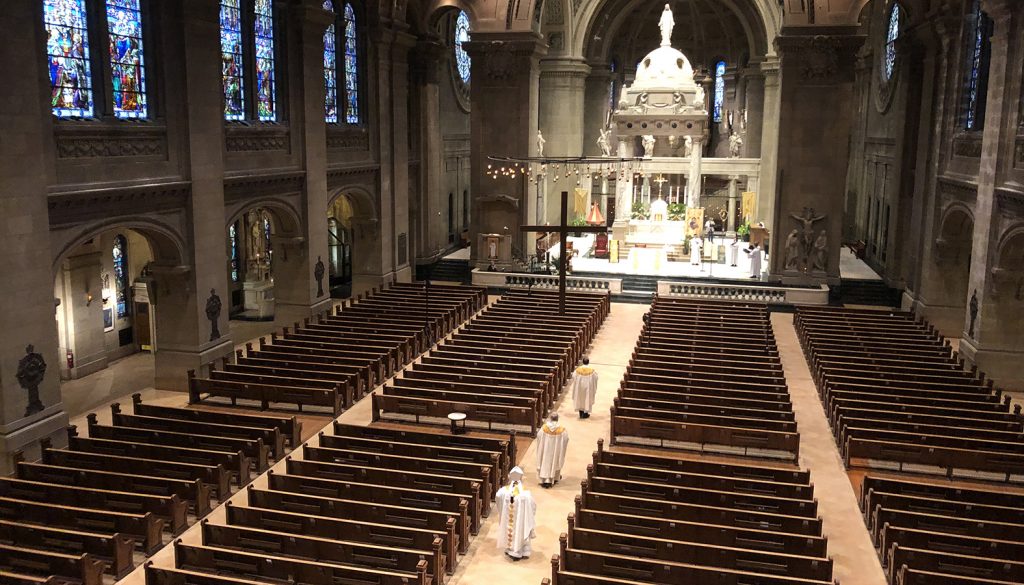ROME — As many countries begin to segue into what the Italians are calling “phase 2” of the coronavirus (COVID-19) pandemic, meaning a gradual loosening of restrictions, the numbers fueling fear aren’t just the infection rate and death count anymore, but also the price tag of the long global lockdown.
With many economists predicting a global recession in 2020, stock markets have experienced their worst crash since 1987 and unemployment spiking. Overall, Oxford Economics is projecting global economic output will decline by 7%, and Bloomberg Economics predicted a month ago the total global economic hit could be as much as $2.7 trillion, equivalent to the entire GDP of the U.K.
To date, no one has tracked the total financial impact of the coronavirus lockdown for the Church, either globally or at the national level. There are considerable signs, however, of a looming catastrophe.
In the Vatican, Cardinal Giuseppe Bertello, president of the government of the Vatican City State, issued a letter to all employees on April 8 announcing an immediate freeze on hiring and promotion, and also indicating that employees who work on fixed contracts should expect their positions won’t be renewed.
The City State is heavily dependent on income from the tourist and pilgrim trade, especially ticket sales at the Vatican Museums but also income from the Vatican bookstore, post office, and related operations. As Cardinal Bertello put it in the letter, there’s no telling when those tourists and pilgrims will be back, so something’s got to be done.
Argentinian Father Augusto Zampini, an adjunct secretary at the Dicastery for Promoting Integral Human Development, recently said the Vatican is presently running on emergency financial reserves, and said some officials have volunteered to take pay cuts to help weather the storm.
In the U.S., there’s similarly no firm estimate for the Church’s economic hit, but some sense of scale can be provided by data from the Center for Applied Research in the Apostolate at Georgetown University, which estimated in 2011 that average annual parish revenue was $695,291, roughly two-thirds of which came from the collection plate at Mass.
Multiplying that number by the 17,139 parishes in the country at the time, the total annual haul from the collection plate for the Catholic Church in America was $8.2 billion. Dividing that total by the 52 weeks of the year, the average weekly collection income would be around $158 million. Since public Masses in most of America have been suspended for the past month, that means the total shortfall could be as high as $632 million.
One piece of good news is that parishes and dioceses have been making more creative use of digital and online appeals, with groups such as GiveCentral, an online fundraising platform specializing in churches, reporting that after the Archdiocese of Baltimore offered online giving from multiple platforms, it actually experienced a 70% increase in donations in March 2020 as opposed to March 2019.
In nations such as Italy and Germany, the impact for the Church from the suspension of Masses won’t be quite as direct since most of their funding doesn’t come from Mass collections but state-administered church tax systems. However, since tax collections likely will drop in 2020, church tax proceeds are likely to experience a corresponding decline.
Moreover, the Italian bishops have already spent $240 million of their roughly $1 billion in church tax income for 2020 on support for hospitals, civil protection agencies, and families hit by the coronavirus, which is money that was earmarked for repairs of church properties.
As the secretary general of the Italian bishops’ conference, Bishop Stefano Russo, put it, “Right now, the needs of people have to prevail over buildings.”
However, the deferred maintenance those allocations represent will have to be faced sometime, and it’s not clear right now where the funds to do so may come from.
All this is without taking into consideration the situation in the developing world, where local churches generally are already making do on limited resources. Even if the pandemic doesn’t break out in Africa, for instance, in the same way it has in other parts of the world, the impact of the global slowdown on the African economy nevertheless will mean significant new demands on Catholic charities and pastoral care.
The United Nations has projected that contracting demand in developing countries due to the pandemic could push 580 million new people, equivalent to 8% of the world’s population, into poverty, and a strong share will turn to the Church for help.
Last week Pope Francis created a commission to oversee the Church’s response to the aftermath of the coronavirus. It’s organized into five task forces, one of which is devoted to finances, and part of its mandate is to raise money for assistance to “local churches and Catholic organizations” struggling because of the pandemic.
Ironically enough, around the same time the commission was announced I was introduced to an Italian after-dinner drink called Cynar, which was popular in the 1950s due to a famous advertising campaign that billed the artichoke-based liquor as effective against “the strain of modern life.”
If Pope Francis really wants to help the members of his financial task force, he might consider sending each one a bottle of Cynar, because whatever the final losses for the Church turn out to be, coping with it all will be a strain of basically unprecedented magnitude.

